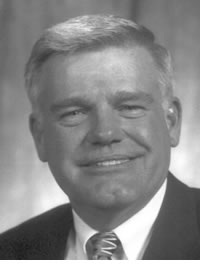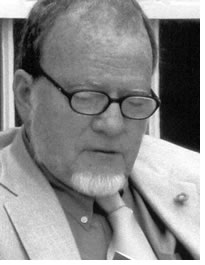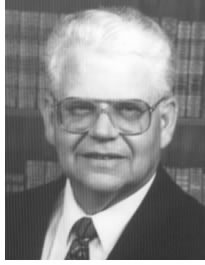

Seven Receive Honorary Membership
by Heather Livingston
Coordinator, AIA Awards
The tenets of the AIA highlight the importance of communication and collaboration with allied professions and clients. Granting Honorary AIA status demonstrates the Institute’s gratitude toward those who support and uplift architects and the profession by acknowledging them as part of the AIA family. The AIA is pleased to announce seven new Honorary Members of the Institute. Their contributions range from recording architectural treasures through photography to building industry alliances; from providing a strong, clear voice for the Institute to faithfully serving and promoting AIA chapter members. These outstanding individuals will be presented formally as Honorary Members in June at the 2004 AIA National Convention in Chicago.
 Mary
E. Fenelon, Hon. AIA
Mary
E. Fenelon, Hon. AIA
As McGraw-Hill Construction’s senior director for alliances, Fenelon’s
contributions affect AIA members daily. A key partner to the AIA and American
Architectural Foundation (AAF), she advances the building profession by
nurturing learning programs through the AIA Continuing Education System
(CES) Marketplace, components, convention, and Grassroots and the AAF’s
exhibitions, PBS-format documentaries, and Accent on Architecture Gala.
Fenelon’s energy, wisdom, leadership, and dedication contribute
greatly to the AIA and the AAF, as well as the 13 other industry associations
she serves.
A true champion of the design community, she has established a McGraw-Hill Construction scholarship program and is highly involved in the CES Conference and Marketplace. Her involvement with the ACE Mentor program in Washington, D.C., has opened education and career opportunities in the building arts to high school students, principally inner-city under-privileged youths. “She finds a way to leverage the many resources of McGraw-Hill Construction in ways that provide benefit to AIA members and components as well as to her company,” wrote Janet Pike, Hon. AIA, executive vice president of AIA Kentucky, in her letter of support. “I am confident the alliances she has built and nurtured will be sustained long after she is gone.”
 Charles
“Chuck” E. Hamlin, Hon. AIA
Charles
“Chuck” E. Hamlin, Hon. AIA
Former team vice president for the AIA national component, Hamlin used
his marketing and communication skills to unify the Institute’s
voice, giving it a clarity and focus previously unrealized. He managed
the evolution of the AIA’s communications from print-based to electronic
format, expanding the frequency, depth, and relevance of member communications.
During his tenure, Hamlin oversaw the redesign of the Institute’s
Web site; launch of AIA/J; conversion
of AIArchitect to electronic format;
implementation of the national advertising campaign; and development of
a long-term strategy to research, define, and develop brand identity for
the Institute.
In her letter of support, Marga Rose Hancock, Hon. AIA, executive vice president of AIA Seattle, enthused “Chuck has melded volunteer zeal and energy with professional resources from public relations and advertising to help create a fresh public image for architects and the AIA. He has had an especially strong impact in the sustained AIA ad campaign, maximizing investment in print, broadcast, and Web media to convey key concepts to the public about architecture.”
 Paul
K. Heilstedt, PE, Hon. AIA
Paul
K. Heilstedt, PE, Hon. AIA
Paul Heilstedt has been a leader in the development of building codes
and standards for more than 30 years. From 1991–2003 he served as
CEO of Building Officials and Code Administrators (BOCA). Under his leadership,
BOCA became the only model code organization that enabled architects to
vote on the disposition of code changes. Additionally, he led the effort
to create and implement the Common Code Format, a common organizational
methodology among the three model codes, which led to the creation of
the International Family of Codes.
“Paul is a recognized authority on the intricacies and complexities of our nation’s codes and standards process, and a champion of its vital importance in insuring that our buildings are safe,” wrote David A. Harris, FAIA, president, National Institute of Building Sciences, in his letter of support. Throughout his career, Heilstedt supported the advancement and improvement of professional design. His leadership provided guidance and support in the development, training, and implementation of quality codes and standards, thereby improving safety for clients and the general public.
 Robert
C. Lautman, Hon. AIA
Robert
C. Lautman, Hon. AIA
The recipient of the AIA Gold Medal for Architectural Photography in 1973
and the Washington, D.C. AIA Chapter’s Glenn Brown Award in 2001,
Robert Lautman ranks among the top U.S. architectural photographers. A
combat photographer in World War II, he received two Bronze Stars for
photographing troops retaking Corredigor and the 6th Rangers liberating
prisoners of war at Cabanatuan, Phillipines. The second Bronze Star was
awarded personally by General Douglas MacArthur. Upon returning to the
U.S., Lautman apprenticed with a New York architectural photographer and
“was charmed” by his subject.
Since opening his practice in Washington, D.C., more than 50 years ago, Lautman has photographed the works of many of the world’s most esteemed architects including Louis I. Kahn, I.M. Pei, Marcel Breuer, Michael Graves, and Thomas Jefferson. He also has provided numerous hours of pro bono services to the Octagon Museum, Washington Architectural Foundation, Mount Vernon, Monticello, and the University of Virginia. M. Elliott Carroll, FAIA, in his letter of support, wrote, “Robert Lautman, through his consummate skill in visual and written communication, has contributed more than anyone else to the public understanding and demand for design quality by his artistry in describing the designer’s intent and skill in visual description.”
 Karen
Lewand, Hon. AIA
Karen
Lewand, Hon. AIA
Executive director of AIA Baltimore since 1992, Lewand amply has demonstrated
her leadership and passion for architecture through service as CACE president,
CACE representative to the AIA Board, and as a member of the AIA Executive
Committee. In her letter of support for Lewand, Kate Schwennsen, FAIA,
remarked, “As the chair of the Board Communication Issue Group,
she has served as our conscience, consistently refocusing us toward strategic
issues of community, knowledge, and advocacy . . . she challenges us to
think about healthy, livable, sustainable communities and how architects
can contribute to the public good. When the national debate moves too
far from home, she reminds us that ‘membership is local,’
and that national decisions and visions must resonate with the local members.”
Serving as chair of the AIA Board Communications Strategic Issue Discussion Group, Lewand advocated increased member communication, a task force promoting sustained advocacy, accessible Institute minutes through the Web site, and creation of the Institute’s annual report. Her leadership established a framework through which the AIA can facilitate the delivery of knowledge, provide appropriate forums for member engagement, and support AIA members’ public service commitment.
 David
Littlejohn, Hon. AIA
David
Littlejohn, Hon. AIA
David Littlejohn has shaped the debate of design through his writings,
seminars, and lifelong interest serving both the public and profession.
Professor emeritus at the Graduate School of Journalism, University of
California at Berkeley, David Littlejohn is an internationally recognized
author, essayist, critic, lecturer and teacher. A former student of architecture
at UC, Berkeley, Littlejohn changed his major to English but retained
his passion for design that has resulted in 13 books, including 3 about
architecture; more than 350 articles and reviews as cultural correspondent
for the London Times, Wall
Street Journal, and public television; and 27 articles on architecture
in AIA print media, the Atlantic Monthly,
and Oxford Press. Through books,
articles, lectures, or public television, he has consistently presented
architecture as an important public topic.
“Through his prolific writings David Littlejohn has advanced the cause of architecture. His advocacy has reached mass audiences as well as erudite, scholarly circles,” writes Lawrence Rinder, the Whitney Museum’s curator of contemporary art. “Because of his immeasurable contributions to the field of architecture and its reputation, I strongly endorse David Littlejohn’s nomination as an Honorary Member of the American Institute of Architects.”
 Lloyd
N. Unsell Jr., Hon. AIA
Lloyd
N. Unsell Jr., Hon. AIA
As executive director of AIA Potomac Valley since 1993, Unsell has promoted
both his chapter and the national component. He initiated diverse programs
supporting architects’ professional growth and has been an advocate
for the profession in Maryland. The component Executive of the Year in
2002, Unsell was CACE Executive Committee director for two years and in
2003 was the vice president for resource development. In that capacity
he raised more than $70,000 for CACE’s annual meeting, enabling
all attendees to receive travel reimbursement.
Unsell generously has contributed his time and services to support the profession. He has independently established a CACE Web site as a resource for component executives, volunteered as CACE photographer, and facilitated architects’ services of more than 100 pro-bono hours in assisting reconstruction efforts of St. Clement’s Island Lighthouse. Noted AIA Managing Director of Component Affairs Brenda Henderson, Hon. AIA, in her letter of support, “He has generously shared his interest and knowledge of technology with his colleagues . . . [he] in short, embodies the AIA’s ‘culture of sharing.’”
Copyright 2004 The American Institute of Architects.
All rights reserved. Home Page ![]()
![]()
 |
||
| Questions about the nomination process should be directed to Robin Lee, Hon. AIA, director, Honors and Awards, rlee@aia.org or 202-626-7390.
|
||